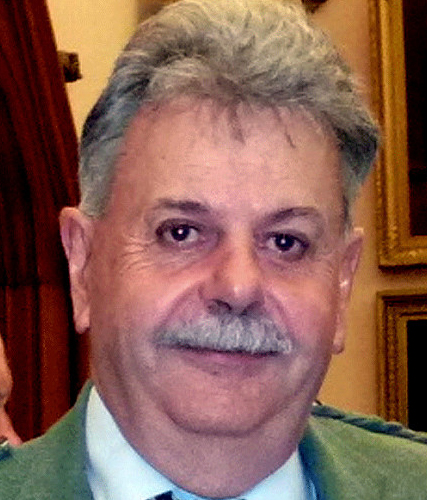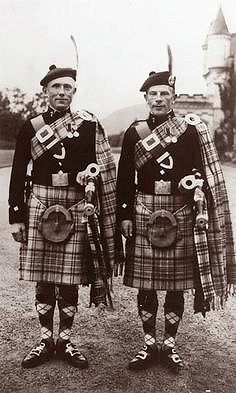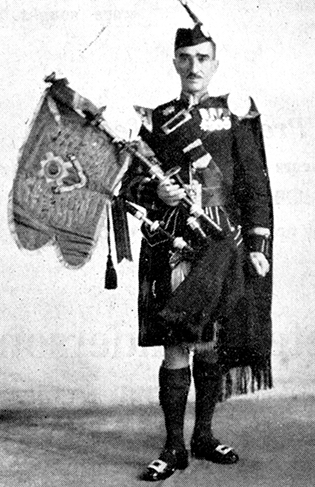Duncan Watson concludes his discussion of these letters and of their importance to all piobaireachd scholars…
The playing of breabach variations gets attention, whether played ‘up’ or ‘down’, but is discussed as more of a musical topic than one of technique. Norman reported Angus MacPherson as lamenting the loss of the tradition whereby the emphasis on the two (breabach) notes was variable according to the foregoing melody.
He cited Isabel MacKay, a tune featured in Binneas is Boreraig where the crunluath is played ‘up’ thus following the timing of the taorluath and according to the melody. James Campbell wrote, ‘I am with Angus MacPherson on this one…’ He went into further detail which should be read in full.
It is tempting to adopt principles and apply them to all tunes with similar types of variation, but it is certainly not necessary, nor indeed desirable, that we should do so – so causing us to all play the same way. As a young piper, I heard James Ross Matheson, a close associate of Angus MacPherson, playing Isabel MacKay with the Binneas timing. This I adopted but when attending Bob Nicol was advised to change it to standard form and did so. Now, hopefully more mature, I tend to play the Binneas style occasionally reverting to the standard. Taking a stance of ‘right’ or ’wrong’ is not appropriate, but I did consider my reverting to the ‘up’ style as being disloyal to Nicol. But all teaching, no matter how musical, does surely allow for personal choice.
The letters go on to consider different types of crunluath such as those found in the MacKays’ Banner and the Battle of the Pass of Crieff. There are about six tunes in the repertoire in which this form exists. The crunluath movements have an open aspect to them in that they are played through the theme note. They are not regarded as fosgailte movements. To get the detail of this I suggest that the letters be consulted.
Specific tunes and details of sources are discussed by James. With the Lament for the Viscount of Dundee he reasons as to why Bob Nicol was taught to play what could be described as an orthodox doubling of D instead of the ‘chelalo’ cadence with the F gracenote we hear today. As ever, James’s reasoning is comprehensive. The End of the Great Bridge is referred to, in particular the unusual F-E-D in the third line in the ground. Nicol said this ornament was something played by the old pipers in tuning preludes and indeed it can be found in the Donald MacDonald book described as ‘part of a Tuning Prelude’. The F E ‘cadence’ seems to be unique (although it is similar to the ‘chelalo’ cadence) and it seems odd that such a thing finds its way into a tune.
This slight difference is another example of ‘fringe’ aspects within tunes, and of John MacDonald’s [Nicol’s teacher] perhaps chameleonic approach to the music – though he never moves outwith the basic framework of the music. In recent times I heard the tune well played, but instead of the F and E gracenotes the piper played G and E. There is arguably an analogous source authority for that, but, amusingly, every time he played the movement his back was to the judges! Perhaps the older pipers did more in the way of varying the way they played than we now appreciate. I would imagine that James Campbell would describe this sort of thing as ‘fringe’ but by avoiding such ‘fringe’ touches as described, we may be in danger of losing them from the repertoire. There are various reasons for this of course, competition playing being the most obvious. Teachers and judges can have positive or negative effect and I am as culpable as anyone.
The value to be given to the F gracenote within the ‘lal’ of ‘chelalo’ is explored at length and makes interesting reading. As an aside, F gracenotes are very common in the works of Donald MacDonald, particularly in dithis variations. For reasons unknown, and with rare exceptions such as in His Father’s Lament for Donald MacKenzie, these have largely fallen out of favour with composers. Of course we should remember that that this tune was composed post Donald MacDonald. In the editorial notes in the Piobaireachd Society setting of the tune there is reference to the F gracenote as though it a mistake. In view of the frequency of use of the gracenote, and its effectiveness, that is unlikely – and the F gracenote does appear in other old sources settings.
James Campbell expresses fascination with the Princes Salute, in particular the pointing of Variation 1 singling. John MacDonald taught Bob Brown it based on Malcolm MacPherson’s playing and the Donald MacDonald notation with the exception of the third line where there are what can be described as breabach beats. James wrote, ‘and Brown’s singing of this style in Track 7 gave me my first understanding of this pointing. I refer to his singing in Track 7 and not to his timing in his playing in Track 8 which seemed to gravitate towards the straightforward Donald MacDonald timing.The [Malcolm] MacPherson style is elusive and attempts have been made (with scant result) to depict it on paper. The singing of Brown illustrates the impossibility of conveying in writing all the nuance of piobaireachd playing. The vocal rendition in Track 7 will be a boon to anyone concerned to appreciate the subtlety of this particular style.’
It may be of interest that I was taught the tune by Bob Nicol and what he taught was based on Donald MacDonald, but he was a bit more straightforward than what Bob Brown taught. In the late 70s I prepared the tune for the Gold Medal at Oban. The late Donald Morrison asked me what my submitted tunes were. I told him that the Prince’s Salute was one of them. Donald, obviously knowing the tune, advised that the D MacDonald timing of Variation 1 would not go down well with the Oban bench and it might be wise to play the tune as timed or pointed in the Piobaireachd Society Book. I determined to continue with my intentions and in event there was no success. That did not unduly bother me. From memory Capt. John MacLellan made reference to what I did in his magazine ‘The International Piper’ along the lines that it was different to what G S Allan had played.
I knew who G S Allan (left) was as Bob Nicol spoke of him. John MacLellan did speak to me and suggested that it was not a good idea to play such a style in the ‘south’. Things are hopefully more liberal now. I had never heard G S Allan play, let alone playing the Princes Salute – he had passed on before my time. However Bob Brown said that he was John MacDonald’s best pupil and I imagine he would have played it as John MacDonald taught and maybe the same way as Nicol and Brown had it. But maybe this is further evidence of the chameleonic approach of John MacDonald? Subsequently I obtained another recording of Bob Brown playing the tune and it follows his Masters of Piobaireachd recording. RU Brown does suggest that it is difficult to catch the essence of the tune and, not being in the same bracket of player as him, I would certainly agree. It is not the fingering, but the elusive timing that presents the difficulty. The tune has been set in recent times at major competitions and it seems that the MacDonald/MacPherson style is being avoided. To tackle what RU Brown imparts in singing is probably a challenge which competition and judging considerations make all the more difficult. This is perhaps another example of how touches, nuances and attractive inflections are being lost and how the bookish or ‘basic’ style of playing is being pursued in the greater likelihood of success, ‘fringe’ elements thus being in great danger of being lost.
At the outset of sharing the letters, Norman Matheson wrote that the production of the Masters of Piobaireachd series was not an attempt to lay down in dogmatic fashion how the music must be played, but was merely a presentation of what RU Brown and RB Nicol were taught by John MacDonald, Inverness. Norman indicated that in his letters James Campbell was generous in his praise of the series and when re-read they are unbiased and comprehensive. Recordings of music give us permanence. The evanescence of electronic written material tends to cause us to read the content and then almost forget it as opposed to having a hard copy for future reference. I would suggest and commend to teachers that they should download and obtain hard copies of the ‘James Campbell Letters’ to accompany the Master of Piobaireachd series, if not for their immediate use, but for their pupils and their pupil’s pupils.




















Recent Comments